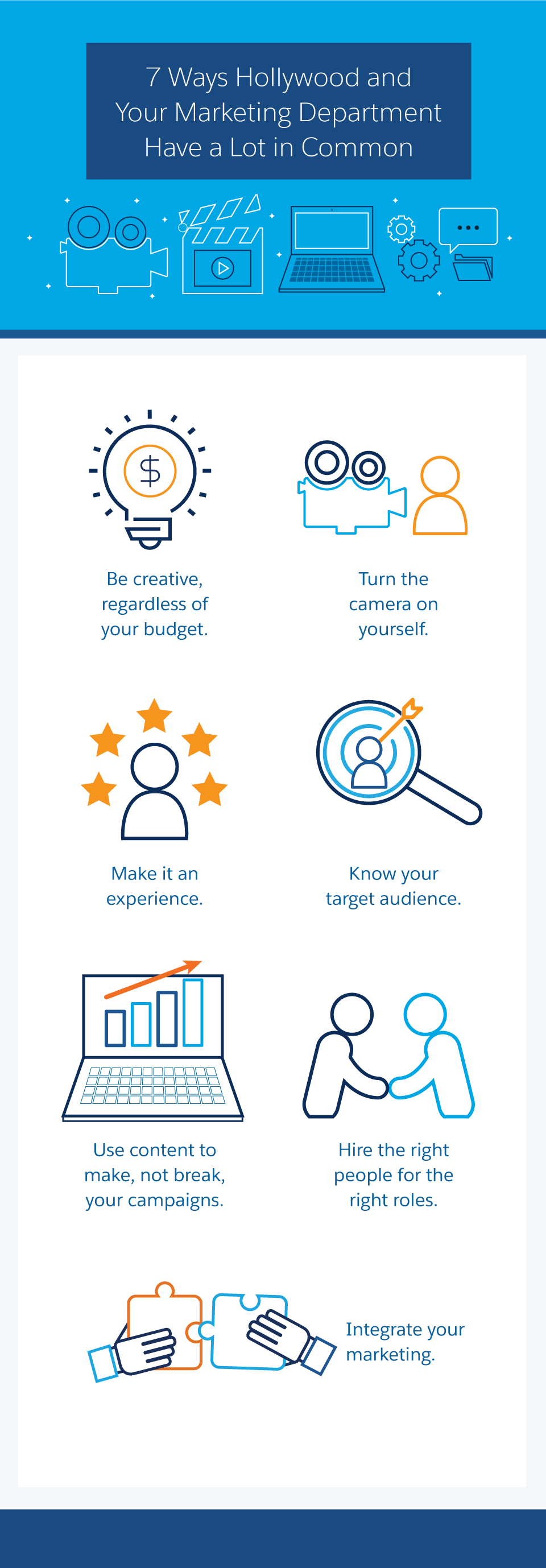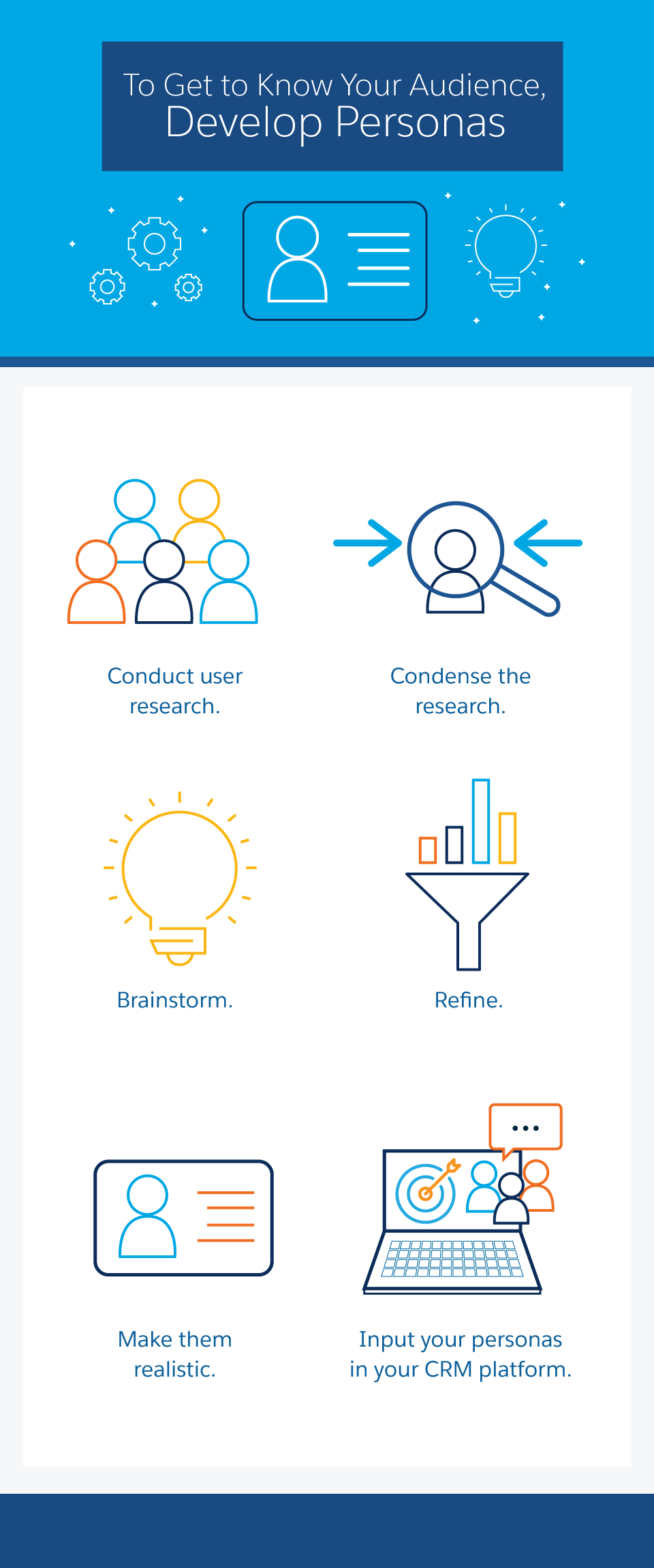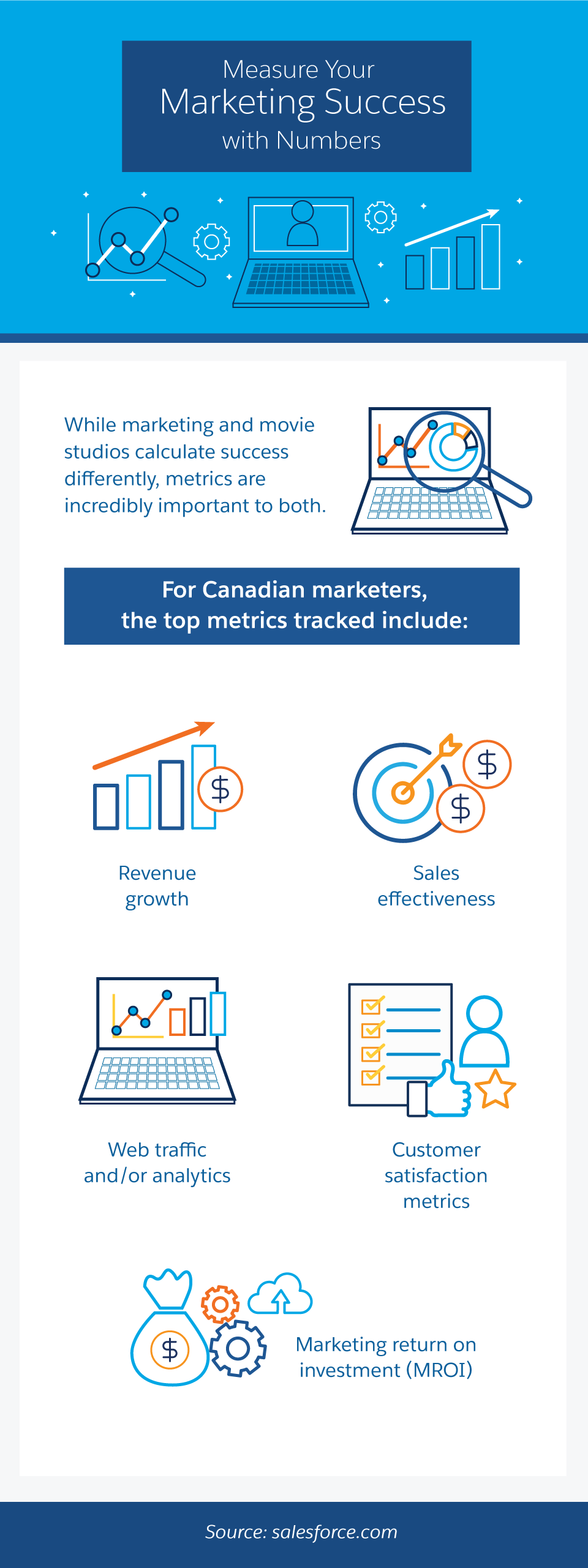Marketers can learn a lot from the movie industry, especially today, as Hollywood and what we think of as the “traditional” film industry goes beyond to include streaming services such as Netflix and Amazon.
Like the entertainment industry, marketers must evolve to remain relevant and reach new fans. So, the next time you watch highlights from a movie premiere, sit down with your tub of buttery popcorn at the theatre, or catch a new trailer on YouTube, take some mental notes — you may pick up an idea or two for your next marketing campaign.

1. Be Creative, Regardless of Your Budget
Money can be a powerful tool for any marketing campaign, but it’s not the only factor. Take, for instance, The Blair Witch Project. The psychological-horror movie, which popularized the shaky “recovered footage”-style of shooting, told the fictional story of three filmmakers who vanished while creating a documentary. The film cost a modest amount to make and promote and featured unknown actors — and then made nearly $25 million worldwide. The sleeper hit became one of the top-grossing movies of 1999. To market it, the team created a website with fake content, which is still online today, adding to the mystique. The film also benefited from positive word of mouth from moviegoers.
What’s the takeaway for marketers? Largely, don’t be afraid to get creative with your marketing: Create a themed social media campaign, offer, or giveaway to drum up interest and support your project. Going all-in can pay off, and it doesn’t have to cost a lot of money. When people appreciate your hard work, they talk about it, which is good considering the majority of consumers trust recommendations from family and friends over other types of advertising. Word of mouth for the win.
2. Turn the Camera on Yourself
A movie trailer is a huge part of promoting a film. It’s an exciting sneak peek at a coming attraction, and gets fans excited for what’s next. Similarly, marketers can use this tactic in business.
Consider a video highlighting your company’s value proposition — what makes you different from the rest and how you serve your customer — or a series that shows a behind-the-scenes look at your office, employees, and events. Per the latter, this is a great opportunity to reward your loyal audience with special access. Like an exclusive look at a new movie, you can tease content about an upcoming release and gain new fans. As an added bonus, you can also cross-promote videos on multiple platforms.
3. Make It an Experience
Marketers can learn a thing or two from Hollywood when it comes to promotion. Experiential, or engagement, marketing creates an immersive experience for consumers. In 2013, the team behind the Carrie remake set up an elaborate prank at a New York City coffee shop. A crew devised rigged tables and a fake wall with a pulley system to help sell that a female customer had telekinetic powers, playing off the lead character in the movie. Unsuspecting patrons witnessed a disgruntled woman “use her mind” to move tables and even send one guy up a wall. The video was published ahead of the movie’s premiere in October 2013. To date, it has over 70 million views on YouTube.
Marketers can, and should, create personalized experiences to connect with their audience. Options ranging from high-end (splashy giveaways or incorporating virtual reality) to more accessible (a customized Snapchat filter or an Instagram-friendly display wall with the event hashtag on it) give marketers plenty of room to get creative and create a memorable experience.
4. Know Your Target Audience
When it comes to promotion, make sure your marketing aligns with your audience. Hollywood wouldn’t heavily promote a movie about two senior citizens going on a road trip to children, so think critically about what you’re promoting and to whom.

The first step is to develop personas that drive your marketing. You can create these personas through a six-step process:
- Conduct user research: Answer essential questions about your customers and company, review Facebook Audience Insights, talk to customers directly, and pull from internal data.
- Condense the research: Look for themes and common characteristics.
- Brainstorm: Organize your research into personas and name each group.
- Refine: Develop several personas based on their identified characteristics.
- Make them realistic: Arrange and further personalize the appropriate descriptions.
- Input your personas in your CRM platform: Create a custom “Persona” field and then run reports.
Much like movie studios hold test screenings, you can gather feedback and tweak your campaigns from there.
5. Use Content to Make — Not Break — Your Campaigns
Disney’s John Carter was a sci-fi adventure film that cost a lot of money to make. The big-budget picture was released in March 2012 and was a major box office bust, losing around $200 million. While there were a few reasons attributed to why it failed, the film’s confusing and frequently changing marketing campaigns were frequently cited.
In addition to determining your target audience, it’s important to know what it is you’re selling and why. A blank check doesn’t guarantee success; John Carter was an expensive production, but a lot of people didn’t know what it was about. The story wasn’t clear to theatre-goers and the marketing was muddled. As a result, it didn’t live up to box office expectations.
Don’t let your marketing campaigns fall into the same trap: Know your “what” and “why.” It’s also essential to note that your team can make or break your marketing, too, so educate and empower your marketers and salespeople. Make sure they know and understand your products and services before introducing them to the market.

6. Hire the Right People for the Right Roles
In the live-action adaptation of Aladdin, Jasmine begs her father to let her take over the kingdom of Agrabah instead of her future husband. In Office Christmas Party, Jennifer Aniston plays a hardworking, no-nonsense executive who’s trying to close her hard-partying brother’s branch of the family business. And in the movie Horrible Bosses... well, you can probably figure that one out. Bad hires can be funny on the big screen. But in real life? Not so much.
According to a CareerBuilder survey, companies lost an average of $14,900 per bad hire. The average cost of losing a good hire was nearly $30,000. While it often feels like we’re in go-go-go mode in marketing, it’s important to be mindful when recruiting and hiring. If there’s a bad fit, do some digging: Is it a culture or skills mismatch? Is the issue with a team member or supervisor?
Whatever the case, see if it’s possible to pivot roles, alter a job description, or come to another solution for both parties. When you leave the work revenge-fantasies for the movies, employee satisfaction will improve, too.
7. Integrate Your Marketing
Movie studios don’t rely on just one promotion method or channel, and neither should you. When you have a new offering, map out your timeline, identify the major players and channels you want to involve, and land on a budget. Similar to a teaser trailer, create buzz beforehand; if you have a devoted following or an insider group, send them the exclusive details ahead of the general public.
Throughout all this, you should determine which channels will yield the best results, but don’t be afraid to experiment. Repurpose your content, try a social media giveaway, or build an email drip campaign to drum up interest. Use an integrated marketing approach to see the best results for your next launch.
Marketing and movies are both meant to be stimulating and interesting. In order to succeed, you have to mind your budget, keep your audience intrigued, and do creative work worthy of attention. Take these lessons from the movie industry to help you create campaigns that are certifiable hits.
Share "7 Lessons Marketers Can Take from the Movies" On Your Site


.jpg)

